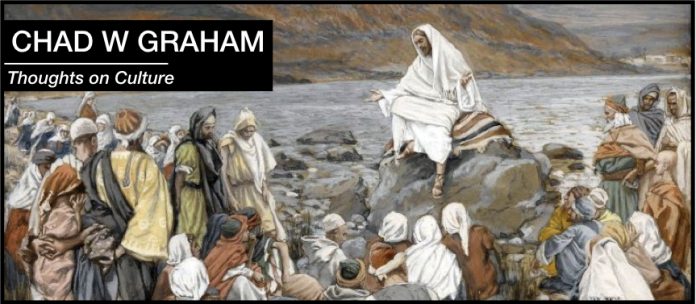What is creative subversion? Driving to my daughter’s ballet recital, I played one of those curated “for you” playlists. Jimi Hendrix began to wail, and my mind wandered, in a natural way, to a contemplation of Jesus’ method of persuasion:
There must be some kind of way outta here/ Said the joker to the thief/ There’s too much confusion / I can’t get no relief.
Bob Dylan’s iconic song (All Along) The Watchtower is considered one of the greatest songs of all time. If you are not sure how this song led me to a contemplation of Jesus’ persuasive strategy, well, … keep reading.
Creative Subversion: All Along the Watchtower
Critics note Dylan’s subversion of chronology as one of the keys to the song (Christopher Ricks Dylan’s Visions of Sin, at 359.) Ricks describes this chronological subversion, noting that Dylan sets up the listener for an epic ballad in the first three stanzas, but pauses the story, entering an extended instrumental narrative. When the lyrics resume, however, The song shifts gears and Dylan draws on the prophecy of Isaiah (see Isaiah 21:5-9):
All along the watchtower
Princes kept the view
While all the women came and went
Barefoot servants, too
Outside in the cold distance
A wildcat did growl
Two riders were approaching
And the wind began to howl.
Ricks observes, “at the conclusion of the last verse, it is as if the song bizarrely begins at last, and as if the myth began again.” (ibid) For the listener, this is a jarring experience.
Creative Subversion: An Introduction to Parables
Matthew (Chapter 13), Mark (Chapter 4), and Luke (Chapter 8) all record The Parable of the Sower. A parable can be defined as “a short allegorical story designed to illustrate or teach some truth, religious principle, or moral lesson.” (Source). This definition makes a parable sound like a really effective teaching method. This can be true. But it is not always the case. Jesus parables required a level of spiritual discernment. He concludes his parable here, with the words, “He who has an ear, let him hear” (Matthew 13:9).
The Purpose of Parables
Jesus disciples asked him why he was speaking in parables. They presumably meant to ask him, “why don’t you just speak plainly?”. Jesus words were fairly direct, “And he answered them, “To you it has been given to know the secrets of the kingdom of heaven, but to them it has not been given.” (Matthew 13:11). The Parable hides, but it also reveals, “And he said to them, “Do you not understand this parable? How then will you understand all the parables?” (Mark 4:13).
A parable, in other words, both explains and obscures. It serves a dual purpose. “to the one who has been given” Jesus explains, “more will be given, and he will have an abundance, but from the one who has not, even what he has will be taken away” (Matthew 13:13). This sounds harsh, but there is a wisdom to it.
In his 7th Epistle, the great Greek philosopher Plato lays out a compelling principle:
He who advises a sick man, whose manner of life is prejudicial to health, is clearly bound first of all to change his patient’s manner of life, and if the patient is willing to obey him, he may go on to give him other advice. But if he is not willing, I shall consider one who declines to advise such a patient to be a man and a physician, and one who gives in to him to be unmanly and unprofessional (source).
Jesus will not cast his pearls before swine (see Matthew 7:6). Parables are the great sorting mechanism. Why?
Creative Subversion: The Parable of The Sower
Hear the Parable of the Sower:
[1] That same day Jesus went out of the house and sat beside the sea. [2] And great crowds gathered about him, so that he got into a boat and sat down. And the whole crowd stood on the beach. [3] And he told them many things in parables, saying:
“A sower went out to sow. [4] And as he sowed, some seeds fell along the path, and the birds came and devoured them. [5] Other seeds fell on rocky ground, where they did not have much soil, and immediately they sprang up, since they had no depth of soil, [6] but when the sun rose they were scorched. And since they had no root, they withered away. [7] Other seeds fell among thorns, and the thorns grew up and choked them. [8] Other seeds fell on good soil and produced grain, some a hundredfold, some sixty, some thirty. [9] He who has ears, let him hear.” (Matthew 13:1–9).
The Context of the Parable
The context of the crowd to whom Jesus spoke is important. Almost everyone in ancient Israel (and the ancient world in general) were subsistence farmers. These folks spent their lives in agriculture and lived by the yield of their crops.
Jesus describes an everyday scene to them, “A sower went forth to sow…” and then he describes some common agricultural occurrences. Some seed falls on the paths that intersected the farms of ancient Israel. Other seed fell in rocky soil that was shallow and would not survive the heat of a middle eastern summer. Some were chocked out by noxious weeds (in an era before pesticides).
We can imagine at this point, that the hearers would be nodding along, “right, right… that is what happens…” They have been lulled into thinking they are hearing a disaster story. The suffering and the challenges that would follow this farming family would be immense. But, where was Jesus going with this?
Conclusion of the Parable
Well, some seed, at least, “fell on good soil…” (verse 8). Too little, too late, the crown might think. But then Jesus continued to describe what happened to this seed in the good soil. The good soil “produced grain,” more nods, “some a hundredfold, some sixty, some thirty.” And at this point, the crowd must have roared in surprise.
Commentators explain that these numbers refer to a phenomenal bumper crop, “typical yields seem to have ranged from about fivefold to fifteenfold” (Nolland, 529). Jesus’ hearers have had a jarring shift, much as Dylan’s hearers would many years later. The story did not go as planned.
Creative Subversion: The Lesson of Jesus
Over and over again, Jesus stories, and questions, and speeches invert expectations. In the Sermon on the Mount, Jesus gives a series of shocking reversals to common moral knowledge, “you [may] have heard it said, ____, but I say to you _____” (see Matthew 5:21, 27, 33, 38, & 43). In response, the people are dumbfounded, “And when Jesus finished these sayings, the crowds were astonished at his teaching, for he was teaching them as one who had authority, and not as their scribes” (Matthew 7:28-29).
Is Real Change Possible?
People are rigidly set in their ways. If you want to change their minds, you have to stun them. Plato was originally a playwright. But after meeting Socrates, he burned all of his writings. This might explain why the surviving corpus of his philosophical writing is almost exclusively found in dramatic dialogue. You can take the playwright away from the theatre, but you cannot take the theatre out of the playwright!
Plato understood that lecturing on philosophy was hardly going to change the world. But, by placing his insights into dramatic form, he popularized his view of the world and created Western Civilisation. As Alfred North Whitehead famously wrote, “The safest general characterization of the European philosophical tradition is that it consists of a series of footnotes to Plato.” (source).
Creative Subversion Leads to Real Change
Plato presents his hero, Socrates, as engaging in a series of dialogues with key individuals (and especially the young pace setters of Athens). He constantly jars them and sets their whole world upside down. Jesus was a master of this form of communication. He constantly sees through the surface issue and challenges his hearers.
In the end the enemies of Jesus were left speechless, “And no one was able to answer him a word, nor from that day did anyone dare to ask him any more questions” (Matthew 22:46). His followers, however, came to a very different state of mind. They recognized that they had “beheld his glory, the glory of the only begotten of the Father” (John 1:14), recognizing that he had “the words of life” (John 6:68).
Creative Subversion: Conclusions
Real change is possible. But it takes something significant. According to Psychology Today, personality changes may take “severe emotional trauma or life-changing events,” significant employment changes, or new romantic relationships to take effect (https://www.psychologytoday.com/ca/blog/media-spotlight/201509/can-you-change-your-personality). It seems that Jesus and Plato knew this thousand of years ago.
Can the church today learn from this? Can we as individual Christians learn from this? We seem to be so concerned to simplify minimizes the message of Christianity. Could it be that by doing this, we are making the mystery of the faith, boring? Could we learn from Jesus (and from Plato) a valuable lesson here? People, it seems, need to be jarred, in order to change their fundamental beliefs.
There are many issues facing the Christian community today. Our society has a fundamentally different view of the unborn, of marriage, of the nature of the good life, and of the nature of reality itself. We may need to be creative to be persuasive. But if we really believe that the Way of Jesus is the right and best way, then it is worth our efforts. We must subvert the dominant paradigm:
All along the watchtower
Princes kept the view
While all the women came and went
Barefoot servants, too
Outside in the cold distance
A wildcat did growl
Two riders were approaching
And the wind began to howl.






My understanding of cognitive dissonance is that within that tension of seemingly (or outright) paradoxical ideas is a necessary precursor for the process of transformation. Without being able to hold something in tension, one cannot learn. Or conversely, one learns something when being able to resolve something in tension (either elevating one idea over the other or transforming the nature of both). I’m pretty sure it’s science. 😀
Also, love the Dylan reference. His stuff has so much theology in it, even before his evangelical transformation in Slow Train Coming in the ’80s where he becomes a Left Behind pre-trib rapture dispensationalist (gotta serve somebody). My favourite is Shelter From The Storm. I’m pretty sure it’s an ode to Sophia, Lady Wisdom herself who was there with God in the beginning of time before the foundation of the world. Romance in it’s highest. 🙂
I also love the parable of the sower. We read an essay on it in my communication class where Stanley Fish contrasts the dissemination obscured-education style of Jesus’ parables with the one to one education of Socrates’ dialectic (where the former is left to interpretation and contemplation and the latter is straight up rote and dictation). He eventually likens God to be the extravagant sower who sows indiscriminately but few will truly latch onto his message/gift. The cross as the most scandalous manifestation of indiscriminate sowing. It was a lot to think about for a secular undergraduate course.
I also really like that you have a blog.
Cheers!
(from CLI…)
James, good to hear from you! Thanks for the comment. Lots to think about in cognitive dissonance and paradoxical ideas. Thank you for engaging in this conversation. I usually find Fish very insightful, but I’m not familiar with the particular essay you referenced. Cheers!